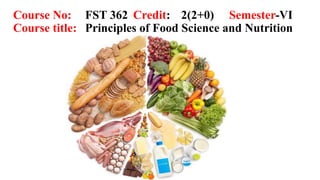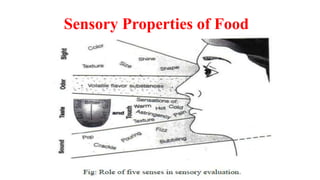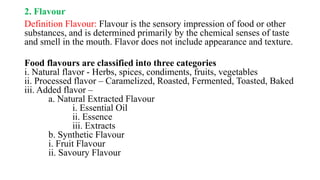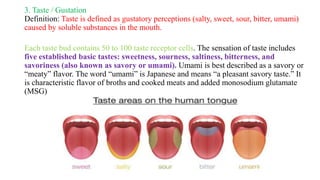SENSEORY EVALUATION.pptx
- 1. Course No: FST 362 Credit: 2(2+0) Semester-VI Course title: Principles of Food Science and Nutrition
- 2. Sensory Properties of Food
- 3. • Foods have several characteristics that require evaluation by sensory methods. The various food attributes that are judged on the sensory scale are flavour, texture, aroma and appearance. • Sensory Properties of food: 1. Appearance 2. Flavor 3. Taste/ Gustation 4. Odor/aroma/fragrance 5. Consistency and texture 6. Chemical / Trigeminal Factors 7. Noise • These attributes are perceived through the 5 senses - sight, smell, touch, taste and sound.
- 4. Sensory Properties of Food
- 5. 1. Appearance The size and shape of food products, together with defects and color, are appearance factors that greatly influence initial consumer impressions. The appearance is an attribute which a decision is taken to purchase or consume. a) Color: Color is a quality factor that greatly influences the appearance of a product. Associated with it are several desirable and undesirable changes in food, such as those occurring during ripening, storage, curing, spoilage, and so on. Deterioration of food is often accompanied by a color change. Color is a character of light, measurable in terms of intensity and wavelength. It is a general term for all sensations arising from the activity of the human eye. When light reaches the retina it sensitizes the nerve mechanisms. The physical tests commonly used for color measurement are the spectrophotometric and the Munsell systems. The Munsell system a tri-stimulus system in which color is specified by three attributes; hue, chroma, and value.
- 6. b) Size and shape: Length, thickness, width, particle size, geometric shape (square, circular, etc.), distribution of pieces, e.g., of vegetables, pasta, prepared foods, etc.; size and shape are indications of quality of products. c) Surface texture: The dullness or shininess of a surface, the roughness, evenness; surface characteristics i.e wet, dry, soft, hard, crisp, tough are indicators of quality. d) Clarity: The haze or opacity of transparent liquids or solids, the presence or absence of particles of visible size are important indicators of quality.
- 7. 2. Flavour Definition Flavour: Flavour is the sensory impression of food or other substances, and is determined primarily by the chemical senses of taste and smell in the mouth. Flavor does not include appearance and texture. Food flavours are classified into three categories i. Natural flavor - Herbs, spices, condiments, fruits, vegetables ii. Processed flavor – Caramelized, Roasted, Fermented, Toasted, Baked iii. Added flavor – a. Natural Extracted Flavour i. Essential Oil ii. Essence iii. Extracts b. Synthetic Flavour i. Fruit Flavour ii. Savoury Flavour
- 8. 3. Taste / Gustation Definition: Taste is defined as gustatory perceptions (salty, sweet, sour, bitter, umami) caused by soluble substances in the mouth. Each taste bud contains 50 to 100 taste receptor cells. The sensation of taste includes five established basic tastes: sweetness, sourness, saltiness, bitterness, and savoriness (also known as savory or umami). Umami is best described as a savory or “meaty” flavor. The word “umami” is Japanese and means “a pleasant savory taste.” It is characteristic flavor of broths and cooked meats and added monosodium glutamate (MSG)
- 9. 4. Odour/ Aroma/ Fragrance • The odor of a product is detected when its volatiles enter the nasal passage and are perceived by the olfactory system. We talk of odor when the volatiles are sniffed through the nose (voluntarily or otherwise). Aroma is the odor of a food product, and fragrance is the odor of a perfume or cosmetic • Volatility is also influenced by the condition of a surface: at a given temperature, more volatiles escape from a soft, porous, and humid surface than from a hard, smooth, and dry one. • Many odors are released only when an enzymatic reaction takes place at a freshly cut surface (e.g., the smell of an onion). • Odorous molecules must be transmitted by a gas, which can be the atmosphere, water vapor, or an industrial gas, and the intensity of the perceived odor is determined by the proportion of such gas which comes into contact with the observer’s olfactory receptors .
- 10. • Definition Aromatics: The term “aromatics” is used to indicate those volatile constituents that originate from food in the mouth and are perceived by the olfactory system via the posterior nares. Retronasal olfaction is the perception of odors emanating from the oral cavity during eating and drinking, as opposed to Orthonasal olfaction, is perception of odors during sniffing. The retronasal olfactory pathway, which contributes to the flavor of foods or drinks, is commonly associated with the sense of taste.
- 11. 5. Consistency and Texture • Tactual and mouth feel play an important role in examining the body and texture characteristics. The pressure between the teeth and jaws determine the hardness, chewiness and gumminess. The fingertips and ball of the thump help in determining other textural attributes, notably stickiness, elasticity/ sponginess and brittleness The other set of attributes to be considered are those perceived by sensors in the mouth Viscosity (for homogeneous Newtonian liquids) Consistency (for non-Newtonian or heterogeneous liquids and semisolids) Texture (for solids or semisolids) • Viscosity refers to the rate of flow of liquids under some force, such as gravity
- 12. • Food texture is defined as those properties of a food that are sensed by touch in the mouth (tongue, jaw, lips) and with the hands. It is sensory indicator of the structure of food products. • We use many words to describe food texture—foods can be soft or hard, mushy or crunchy, or smooth or lumpy. Texture is important to the enjoyment and acceptability of foods. Ex. Would you enjoy a mushy apple or soggy toast? • Tactile feel properties, measured as geometrical particles (grainy, gritty, crystalline, flaky) or moisture properties (wetness, oiliness, moistness, dryness) by the tactile nerves in the surface of the skin of the hand, lips, or tongue.
- 13. • Other Properties The Components of Texture Hardness: force to attain a given deformation : Firmness(compression) Hardness (bite) Cohesiveness: degree to which sample deforms (rather than ruptures) Adhesiveness: force required to remove sample from a given surface Sticky (tooth/palate) Denseness: compactness of cross-section Dense/heavy Airy/puffy/light Springiness: rate of return to original shape after some deformation Springy/rubbery Cushy • Geometrical Properties: perception of particles (size, shape, orientation) measured by tactile means Smoothness: absence of all particles Gritty: small, hard particles Grainy: small particles Chalky/powdery: fine particles (film) Fibrous: long, stringy particles (fuzzy fabric) Lumpy/bumpy: large, even pieces or protrusions
- 14. • Moisture Properties: perception of water, oil, fat, measured by tactile means Moistness: amount of wetness/oiliness present Moisture release: amount of wetness/oiliness exuded/ Juicy Oily: amount of liquid fat Greasy: amount of solid fat
- 15. 6. Chemical / Trigeminal senses Definition: The trigeminal system is a chemical sense which allows the perception of chemosensory stimulus such as burn, heat, cold, pungency, spiciness etc The "trigeminal senses", which detect chemical irritants in the mouth and throat, may also occasionally determine flavor. Chemical irritants such as ammonia, ginger, horseradish, onion, chili peppers, menthol, etc. stimulate the trigeminal nerve ends, causing perceptions of burn, heat, cold, pungency, etc. in the mucosa of the eyes, nose, and mouth.
- 16. 7. Noise The noise produced during mastication (chewing) of foods is a minor but not negligible sensory attribute. ÔÉòIt is common to measure the pitch, loudness, and persistence of sounds produced by foods. ÔÉòThe pitch and loudness of the sound contribute to the overall sensory impression. ÔÉòDifferences in pitch of some rupturing foods (crispy, crunchy, brittle) provide sensory input, which we use in the assessment of freshness/staleness. Common Noise Characteristics of Foods, Pitch: frequency of sound, Crispy, Crunchy, Squeak Loudness: intensity of sound Persistence: endurance of sound over time, Perceived sounds (pitch, loudness, persistence) and auditory measurement
- 17. SENSORY EVALUATION OF FOOD • Definition: Sensory evaluation has been defined as a scientific method to evoke, measure, analyze and interpret those responses to products as perceived through the senses of sight, smell, touch, taste and hearing • In food and beverage companies, sensory evaluation of products can provide an understanding of the key sensory properties that drive consumer acceptability. • Tests for sensory evaluation are of three types: • 1. Discrimination / Difference testing - This is the sensory testing designed to determine whether detectable differences or similarities exist between the products. • i. Triangle test – Panelist is presented with one different and two alike (same) samples. The panelist is instructed to identify the odd sample and record his answer. • ii. Duo – Trio test - Panelists are presented with a reference samples, and then two test samples; one sample is the same as the reference, and the other is the sample to be tested. Panelists are asked to identify the sample that is the same as the reference sample. • iii. Paired comparison test – Panelists are given two samples and asked which one is preferred. It is the difference test in which a specific characteristic (ex sweetness) is to be evaluated in two samples, and the sample with the greater level of that characteristic is to be identified
- 18. 2. Preference / Affective testing - It is the sensory testing to determine the acceptability or preference or liking between products. • i. Rank order: Preference or difference test in which all samples are ranked in order of intensity of a specific characteristic (ex sweetness) • ii. Hedonic Test: The hedonic scale may be used to determine degree of acceptability of one or more products. This scale is a category-type scale with an odd number (five to nine) categories ranging from “dislike extremely” to “like extremely.” A neutral midpoint (neither like nor dislike) is included. Consumers rate the product on the scale based on their response. 3. Descriptive testing - It is the testing which provides information on selected characteristics of food samples and determining the sensory profile of the products. It uses of key or descriptive words in sensory evaluation to characterize food samples.
- 19. Chemical Properties of Food • Basic food chemistry deals with the three primary components in food: carbohydrates, lipids and proteins and other components water, vitamins, minerals, flavours, colours, miscellaneous bioactives • The foods which we use daily include rice, wheat, dal, vegetables, fruits, milk, eggs, fish, meat, sugar, butter, oils, etc. These different foods are made up of a number of chemical components called nutrients. • These are classified according to their chemical composition. Each nutrient class has its own function, but the various nutrients must act in unison for effective action. • The nutrients found in foods are — carbohydrates, proteins, fats, minerals, vitamins and water. • Fibre is also an essential component of our diet. • The functions of nutrients are given below.
- 20. 1. Water: We get water in foods we eat and a major part from the water we drink as such and as beverages. Water is an essential part of our body structure and it accounts for about 60 per cent of our body weight. Water is essential for the utilisation of food material in the body and also for elimination of food waste. It is a regulator of body processes such as maintenance of body temperature. 2. Carbohydrates: Starch found in cereals and sugar in sugarcane and fruits are examples of carbohydrates in foods. The chief function of carbohydrates is to provide energy needed by our body. Those not used immediately for this purpose are stored as glycogen or converted to fat and stored, to be mobilised for energy supply when needed. 3. Proteins: Casein from milk, albumin in egg, globulins in legumes and gluten in wheat, are examples of proteins occurring in foods. The main function of protein is the building of new tissues and maintaining and repair of those already built. Synthesis of regulatory and protective substances such as enzymes, hormones and antibodies is also a function of food proteins. About 10 per cent of the total energy is supplied by proteins in the diet. Protein, when taken in excess of the body’s need, is converted to carbohydrates and fats and is stored in the body.
- 21. 4. Fats: Oils found in seeds, butter from milk, and lard from meat, are examples of fats found in foods. Fats are concentrated sources of energy, carriers of fat soluble vitamins and a source of essential fatty acids. If excess fats are taken in the diet, these are stored as fat reserves in the body. Energy taken in excess of body needs, is stored as fat in the body. 5. Minerals: The minerals calcium, phosphorus, iron, iodine, sodium, potassium and others are found in various foods in combination with organic and inorganic compounds. Minerals are necessary for body-building, for building of bones, teeth and structural parts of soft tissues. They also play a role in regulation of processes in the body, e.g., muscle contraction, clotting of blood, nerve stimuli, etc. 6. Vitamins: Fat-soluble vitamins A, D, E and K and also water-soluble vitamins C and B group are found in foods. These are needed for growth, normal function of the body and normal body processes.




















